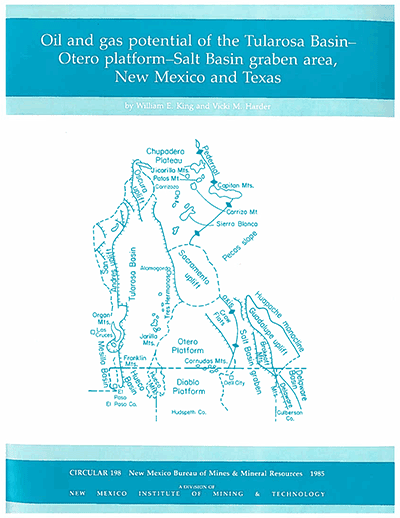
Circular 198—Oil and gas potential of the Tularosa Basin–Otero platform–Salt Basin graben area, New Mexico
By W. E. King and V. M. Harder, 1985, 36 pp., 8 tables, 24 figs., 5 sheets.

This area has remained inadequately explored for hydrocarbons. In the Tularosa Basin, analyses of drill-stem tests indicate a potential for significant gas reservoirs in the Pennsylvanian and Permian portions of the stratigraphic section. Although no oil and gas tests indicate a strong probability of production from the Otero platform, possible hydrocarbon-bearing traps are postulated. Wells drilled to date in the Salt Basin graben have been less than promising, mainly because of recent faulting that allowed fresh water to flush the reservoirs.
The Tularosa Basin–Otero platform-Salt Basin graben area has until now remained inadequately explored for hydrocarbons. Examination of numerous lithological loess, borehole geophysical logs, and gravity data together with the construction of four detailed cross sections reveal a complex fault-block structure of the Tularosa Basin. Noteworthy is the distribution of predominantly Paleozoic source and reservoir beds. Analyses of drill-stem tests of the Houston Oil and Minerals No. 1 Lwelling and the Hodges No. 1 Houston test wells drilled near Three Rivers, New Mexico, indicate a potential for significant gas reservoirs in the Pennsylvanian and Permian portions of the stratigraphic section. A structural contour map on the top of the Precambrian and isopach-lithofacies maps of the Tularosa Basin show a thick and varied Paleozoic section to be explored with a high probability of success in the search for hydrocarbons.
The Otero platform is heavily influenced by the buried Pedernal uplift, as shown by isopach maps and two east-west cross sections. Although no oil and gas tests indicate a strong probability of production, possible hydrocarbon-bearing traps on the east and west flanks of the Pedernal uplift are postulated. There could be reef trends of Permian age. Problems that exist, however, are the uncertainty of the presence of adequate trap-sealing beds, the distance from major hydrocarbon source beds in the Delaware and Otero Basins, and the introduction of fresh water into reservoir beds due to Pliocene-Pleistocene faulting. The Salt Basin graben area of New Mexico and Texas is illustrated by north-south and east-west cross sections showing both source and reservoir beds. However, wells drilled to date have been less than promising, in a large measure due to recent faulting which allowed fresh water to flush reservoirs.
$10.00
Buy
Now
Also available as a free download.
Download
| File Name | Size | Last Modified |
|---|---|---|
| Circular-198.pdf | 20.47 MB | 01/11/2021 03:44:31 PM |



